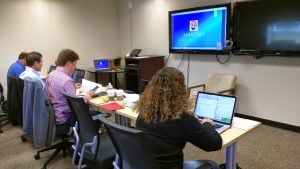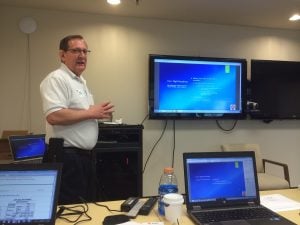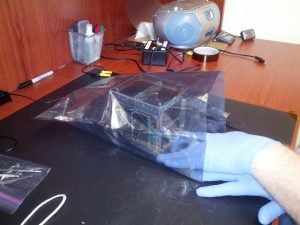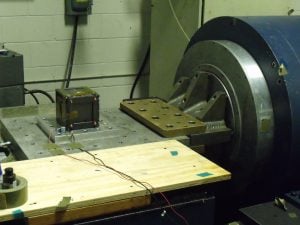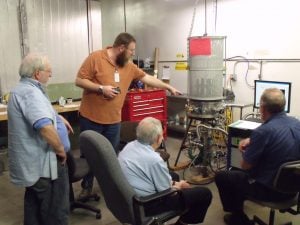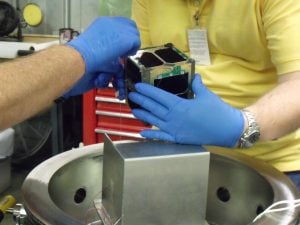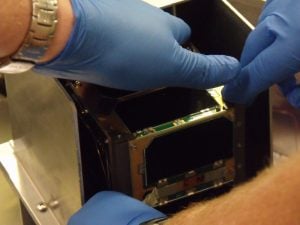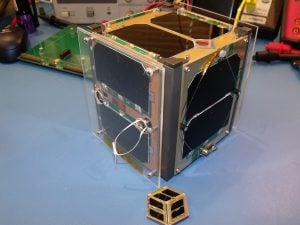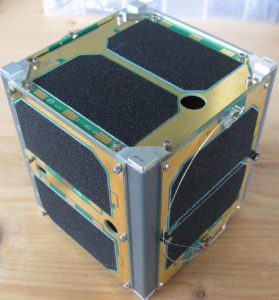Fox-1 “In The Bag”!
Fox-1, the first Fox-1 series satellite (a.k.a. Fox-1A to the AMSAT Engineering Team) completed the final required testing January 16 through 23.
The tests included the launch provider required “DITL” (Day In The Life) and “environmental testing” subjecting the CubeSat to Vibration and Thermal Vacuum Bakeout, the latter two sometimes referred together as “shake and bake”.
DITL is required to show that Fox-1 will not deploy her antennas nor transmit any signals prior to a minimum of 45 minutes after she is deployed from the PPOD into orbit. The test was conducted at the “Fox Labs” QTH of Jerry Buxton NØJY on January 16. Bob Fitzpatrick KB5SQG assisted on site with Jonathan Brandenburg KF5IDY and Kevin Bishop KG7NSD supporting via GoToMeeting. It was a somewhat suspense filled test waiting for 45 minutes hoping nothing will happen, followed by another 11 minutes hoping something will happen. Everything performed as expected and the test was a success, with transmit antenna deployment at 56 minutes 21 seconds, receive antenna deployment at 56 minutes 32 seconds, and first transmission at 59 minutes 12 seconds.
On Monday January 19 Fox Engineering Team members Bob Davis KF4KSS, Burns Fisher W2BFJ, and Jerry Buxton NØJY traveled to Orlando FL to conduct the “shake and bake” at Qualtest.
Upon arrival Fox-1 was tested, inspected, and integrated into the TestPOD at the hotel and then the team traveled to Qualtest. Assisted by Lou McFadin W5DID, photographed by Dave Jordan AA4KN and observed by Ed Krome K9EK the vibration testing took place on Wednesday January 21 with frequencies and amplitudes that simulate the ride Fox-1 will be experiencing on the Atlas V rocket during launch, tested in all three (X,Y,Z) axes. After the “shake” a Short Functional Test and Aliveness Test were conducted, and Fox-1 worked like a charm!
Thursday January 21 Fox-1 was put into the thermal vacuum bell jar to be subjected to a 12 hour pre-soak at high altitude and temperature near the required test temperature in order to remove any rough contaminants that might harm the ion pump used during the “bake” procedure. Friday the 22nd Fox-1 went through the launch required Thermal Vacuum Bakeout which sustains a vacuum <1E-4 torr at a specified temperature for 6 hours in order to thoroughly remove any contaminants that might be left over from construction and handling and which could cause problems once the satellite and materials are exposed to the vacuum of space. Given the vacuum actually achieved during the process, we are very happy that Fox-1 was a “clean machine” even prior to the start of the procedure! Once the “bake” was complete Fox-1 was allowed to cool to near room temperature and then subjected to the same Short Functional Test and Aliveness Test as done on arrival in Florida and after the vibe test. Once again, Fox-1 worked as it should and was officially declared ready for launch!
While it is somewhat anti-climactic, Fox-1 was then carefully placed in an anti-static bag and will remain there until delivery and integration into the PPOD which is scheduled for mid-March 2015. Battery will be charged by the umbilical but no other handling, changes, testing, or function can be performed as once she passed the environmental testing Fox-1 officially became “hands off”.
As previously announced launch is scheduled for late August 2015.
Official photos and more information will be included in an upcoming AMSAT Journal. If you are on Facebook, the AMSAT North America Facebook page has some photos that were uploaded during the environmental testing.
Thanks NØJY and the Fox-1 Engineering Team for the information.
=============== UPDATE ===============
Fox-1 Continues Preparation for Launch
Following the successful conclusion of vibration and thermal/vacuum testing
Fox-1 now is stored in a clean environment waiting for launch. However,
there is still work going on behind the scenes.
AMSAT Vice-President Engineering, Jerry Buxton, N0JY says several required
reports are being reviewed by the launch provider. We continue to make
necessary updates if they request further information in order to be sure
that all of the i’s are dotted and the t’s are crossed. The paperwork is an
ongoing full workload in itself, both during the design and construction and
even after Fox-1 was finished.
For the remaining schedule, Fox-1 will have its Mission Readiness Review
(MRR) at Cal Poly in San Luis Obispo CA on February 24 before a review board of
Cal Poly and NASA representatives. Next, Fox-1 will be delivered and
integrated into the P-POD at Cal Poly during the week of March 16. Then the
countdown begins.
[ANS thanks AMSAT Vice-President Engineering, Jerry Buxton, N0JY for the
above information]
=============== UPDATE ===============
Fox-1A delivery/P-POD integration is now set, for March 25, 2015 at Cal Poly in San Luis Obispo. From there, we won’t see her again – but certainly look forward to hearing from her again!
